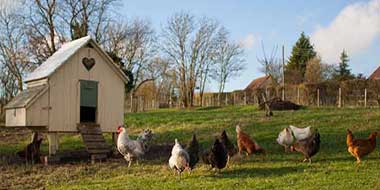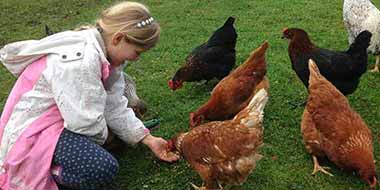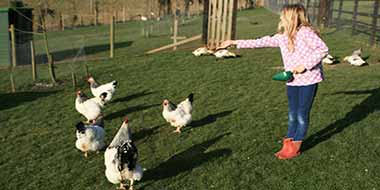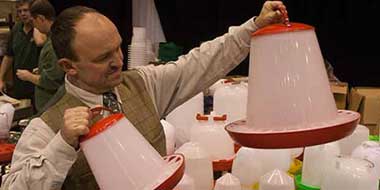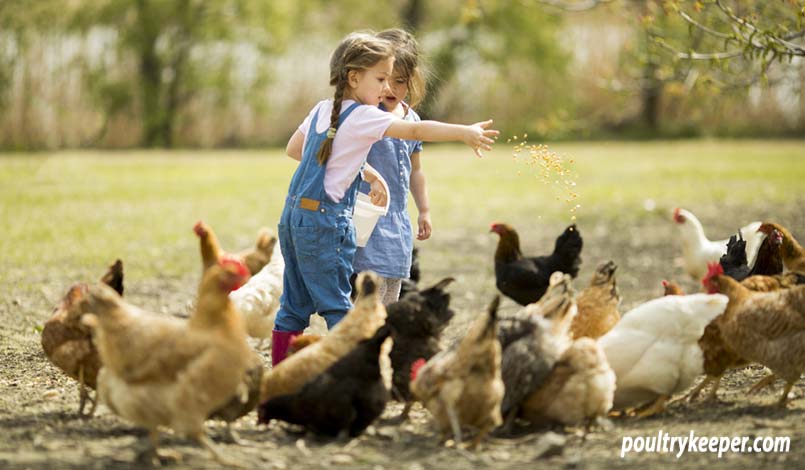
Domesticated chickens, especially modern hybrids, are fantastic egg layers; however, this performance increases nutritional demands, so how we feed our chickens has never been so important.
To keep our chickens healthy and productive, they will need to receive the correct balance of nutrients, vitamins and minerals in their diet. They also limit their intake according to their energy requirements, so when we are feeding chickens, they must fill up on the right things first.
Eggs are mostly protein, so hens must have enough of this in their diet to be able to produce all the eggs we ask of them. “Eat up your greens first” isn’t the best advice when it comes to feeding chickens!
Feeding chickens is surprisingly simple if you understand the basic nutritional requirements of a hen, what she will eat (given half a chance), and then follow a few simple rules to ensure she is eating enough of the right food.
There’s no rocket science here. It’s just ‘different’ to what most people would assume. By the time you reach the end of this article, it will all make perfect sense, so please read on!
This guide is one of three in our feeding chickens series:
Feeding Chickens Series:
Nutritional needs of chickens change with age, so I have split feeding into two articles. This guide covers chickens over 18 weeks of age.
- Feeding Chicks - What to feed chicks from day old to five weeks and growers from six to eighteen weeks old.
- Feeding Chickens (this article) - What to feed pullets from the point of lay around 18 weeks.
Our chickens are omnivores: they will eat vegetable matter and grains, but they will also obtain protein from animals given a chance. Most people know that pasture-raised chickens will eat slugs, snails and insects, these are considered a natural part of their diet, but frogs and even mice are relished if they stray into the chicken run!
Chicken’s teeth are rare! Of course, your chickens don’t have teeth, and their digestive system is very different from ours. They break down their food into small pieces with their beak, soften it with digestive juices, and then break it down further by mechanically grinding using small amounts of grit in their gizzard. They finally absorb their nutrients using bile and digestive enzymes.
How to feed chickens
Chickens will eat until they meet their energy requirements, so we must ensure they obtain most of their energy from food that has the right balance of nutrients, especially protein that is required to produce eggs.
Feeding chickens can be relatively straight forward if you use a formulated, complete feed to suit the age of your birds.
For backyard poultry keepers, almost all chicken feed comes as a pellet which contains all of the nutrients, vitamins and minerals they need. It is a complete, balanced diet and you could (in theory) only feed them with this and plenty of fresh water.
Chickens love to scratch and providing additional scratch feeds and pasture for foraging keeps them active and entertained, but we do need to get the balance right.
As a general rule of thumb, a complete feed should make up 90% of their diet.
Choose the feed that’s suitable for the age of your birds ad-lib in a feeder—for example, layers pellets for hens over 18 weeks old.
Complete feeds
Formulated, balanced feeds for chickens.
There are several types of formulated, complete chicken feeds available:
- Chick Crumbs - Fed from day old to 5 weeks.
- Growers Pellets - Fed from 6 to about 18 weeks.
- Layers mash or crumble - Fed from 18 weeks to laying hens.
- Layers pellets - Fed from 18 weeks to laying hens. The most popular chicken feed.
- Breeders pellets - Fed before and during the breeding season for optimum nutrition.
- Cockerel fattener pellets - Fed from grower stage to slaughter.
 The reason for the multitude of feed choices is because of the different nutritional requirements during the various stages of a chicken’s life.
The reason for the multitude of feed choices is because of the different nutritional requirements during the various stages of a chicken’s life.
Chick crumbs, for example, are high in protein to assist growth, layers pellets are high in protein to support laying and contain additional calcium for the production of eggshells.
Feeders
Feeders or hoppers come in a range of sizes. A complete pelleted feed must be kept dry, so you have to either place the feeder under cover or have one with suitable rain hat.
Not all feeders are waterproof, even though they may look as if they are. Smaller ‘hats’ will need a little shelter from horizontal/blowing rain.
I would suggest using a hopper that can hold at least 3-4 days of feed which will save you topping it up as much, and it will keep your birds fed if you go away for a weekend and have neighbours or friends looking after your chickens.
6KG FEEDER WITH
RAIN HAT
Here is my favourite feeder. It holds 6KG which is large enough for most backyard flocks.
If you have a large flock, it is better to have more than one small feeder, instead of one large one, so hens at the bottom of the pecking order can feed without getting bullied.
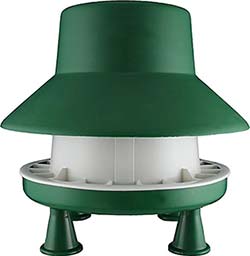
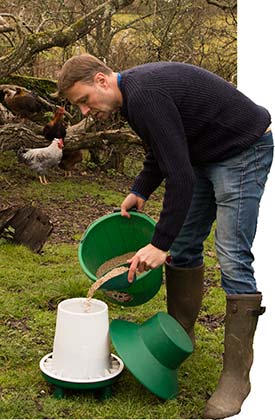
Quick questions
A chicken’s daily feed intake depends on her size and age and whether she is laying. During cold weather, chickens also require more energy to keep warm, consuming more.
How to feed chickens – As a general rule of thumb, feeding chickens of medium-size and free-range allow 115 grams, approximately 1/4 of a pound per day. Typically, a complete feed is offered ad-lib in a feeder to ensure they get the correct nutrients balance.
Most people provide feed in a hopper that is always available, but if you prefer, you can feed them twice per day.
- Once in the morning.
- Once in the late afternoon, at least an hour before it gets dark.
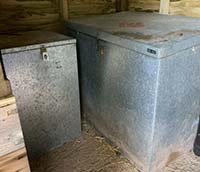 No matter what feed you require for feeding your chickens, you will need to keep feed dry, out of sunlight and safe from rodents. Only store what you can use before the best before date.
For small amounts of feed, most people use an airtight plastic container. For larger quantities, a galvanized feed storage bin is best.
No matter what feed you require for feeding your chickens, you will need to keep feed dry, out of sunlight and safe from rodents. Only store what you can use before the best before date.
For small amounts of feed, most people use an airtight plastic container. For larger quantities, a galvanized feed storage bin is best.Cheap chicken food often means inferior quality ingredients, and can be a false economy. With creative marketing on the outside of the bag, it’s hard to assess the ingredients in poultry feed.
You may not notice problems until after several months. I find the hatchability of eggs and the health of chicks is a good indicator of the quality of nutrition your hens are receiving.
Feeds that include grit are cheaper. Keep in mind the weight of the grit is included in the cost, and your hens will need to eat more of this feed to meet their energy requirements. It can be challenging to make a price comparison with standard feeds.
I prefer to feed grit separately, and my hens can take what they need.
Keeping the diet balanced
Treats, greens and other goodies.
We all like to provide treats, garden scraps and other goodies for our chickens, but keep in mind most of these are have lower nutritional value and dilute/unbalance the nutrients they need in their diet to lay well.
We like to think our chickens will eat what’s right for them, but this isn’t always the case because our chickens are eating to meet their energy requirements, so if you provide mixed corn, they will prefer this over the layers pellets.
This is why we should mostly feed chickens a complete formulated feed and as a general ‘rule of thumb’ we should make sure at least 90% of their diet is a balanced feed, and no more than 10% is other feedstuff.
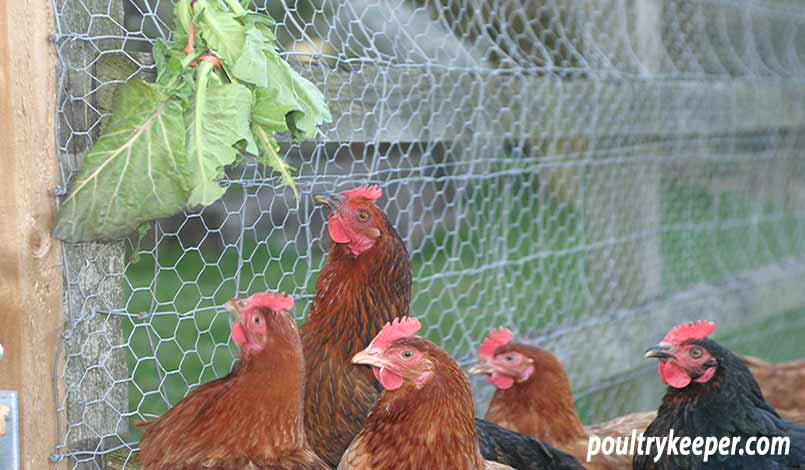
The old-fashioned farmyard approach of feeding chickens kitchen scraps, and leaving them to scratch around for the remainder of their diet will not work if you want your chickens to be healthy and produce eggs.
Before the 1970s, chickens were often fed scraps, with a little wheat or oats, sometimes maize, and fishmeal to increase protein, Cod liver oil provided vitamins, however, modern research has been able to provide us with compound feeds that contain the right balance for our chickens.
If you feed vegetable scraps or treats, you will need to provide insoluble grit for your hens to digest their food correctly and top up their calcium by providing limestone or oyster shell grit.
Feeding Chickens: My routine
The morning feed is the next day's eggs and should be mostly protein. I provide a complete balanced layers feed ad-lib in a hopper. This is available throughout the day.
The afternoon feed keeps them warm through the night. It is usually a handful of grain per hen scattered across their run in the late afternoon. It may contain a few garden scraps and fruit, but it is limited to no more than 10% of their diet. If they are still hungry, they eat layers pellets.
Mixed grit (a mixture of soluble oyster shell for calcium and insoluble granite for digestion) is available free-choice in a hopper which gets topped up from time to time.
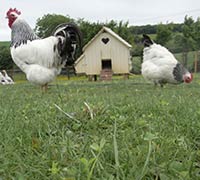
What you can feed chickens
Mixed poultry corn
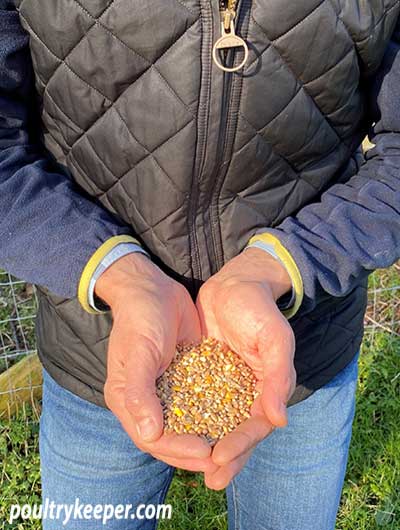 The most significant mistake people make is feeding chickens too much-mixed corn.
The most significant mistake people make is feeding chickens too much-mixed corn.
Mixed corn is usually a mixture (80 to 90%) wheat and (10 to 20%) cracked maize (the yellow bits).
Chickens love corn and will eat it rather than a complete layers feed.
The main ingredient of mixed corn is wheat which provides energy but has lower in protein (usually around 10-12%) than layers pellets, so your chickens won’t have sufficient protein to produce as many eggs.
Corn provides energy so is useful to feed during cold weather or just before bed to help them produce heat to stay warm, but maize is exceptionally high in energy.
If you remember, chickens will eat until they have met their energy requirements, so it’s easy for them to fill up on corn, unbalance their diet, get fat and lay poorly.
Tip: Mixed Corn
Mixed corn is low in protein, high in energy and lacks essential vitamins and minerals required by chickens. Feed no more than a handful per day as a treat. Scatter to encourage foraging and exercise.
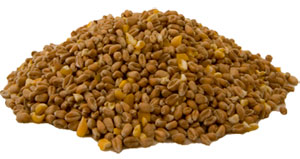
Garden scraps
Almost every green leafy vegetable you produce in your garden or buy can be given to chickens. You can include things like chopped cabbage and cauliflower leaves, spinach, Swiss chard.
You can also feed grass clods (including the mud, because they will get minerals and grit from these as well), grass clippings, chopped herbs, dandelions and other green weeds around the garden.
Lettuce has little nutritional value and can cause the runs.
Boil potatoes or potato peelings first – you must never feed green potatoes, rotten or mouldy food.
Keep everything fresh.
Avoid feeding your chickens onions and spring onions because these will taint the taste of their eggs. I also discovered wild garlic leaves cause the same problem as does fish, yet I don’t notice any change in taste when feeding hens crushed garlic cloves.
Garlic is healthy for chickens, and I add a couple of cloves crushed into their water. I believe it has made a positive difference in their health. What’s more, a few cloves of fresh garlic won’t break the bank if you’re keeping chickens on a budget.
Do not feed rhubarb leaves or avocado pear as these can be poisonous to hens. Having said this, I have seen hens eat young rhubarb leaves when free-ranging and have still lived to lay another egg, but they don’t seem to eat the bigger/older leaves.
Thankfully, chickens seem to know what they can eat when free-ranging instinctively.
Related Articles:
- List of Poisonous Plants for Chickens - A list of typical garden and hedgerow plants and foods that are poisonous to chickens.
- Garlic for Chickens - I have seen positive results feeding garlic to my chickens.
- Apple Cider Vinegar for Chickens - You can add ACV, a popular tonic to your chicken's water.
Peas make great treats for training your chickens, and my favourite treat and nutritious snack for my girls are sprouted grains. Wheat is easy enough to germinate on a tray with a little water if you keep it in a warm place.
Fruit
You can give fruit to your chickens as well, but only feed it in small amounts, and avoid citrus fruits such as oranges and lemons. They love soft fruits like strawberries, grapes, bananas, apples and pears.
Kitchen scraps
In the EU, and Great Britain animal by-product legislation says that the feeding of farmed animals (or in the backyard chicken keeper’s case, farm animals, kept as pets) with catering waste is illegal. It acts as a barrier to the introduction of potentially devastating animal diseases, such as Bovine spongiform encephalopathy (BSE), commonly known as mad cow disease. There were four million cows killed during the eradication programme in the UK, after an outbreak during the 1990s.
Catering waste is classified as all waste food from catering facilities (for example, from a restaurant) but also household kitchens.
It even includes vegetarian kitchens, because of the risk of cross-contamination from products of animal origin such as milk.
In short, you are not allowed to take leftovers from your kitchen and feed them to your chickens.
If garden, allotment or purchased vegetables enter your kitchen, you are no longer supposed to feed these to your hens.
I talk about feeding garden or allotment scraps in my articles. You are allowed to feed these scraps if they haven’t entered your kitchen.
Nutrition from pasture
Free-range hens (pastured hens if you’re in the US) will eat grass, clovers, seeds, some weeds and other plants in the garden. The nutritional value of grass varies, (there are many different kinds of grass and herbages), and the time of year (nutritional values peak in the spring), although unfortunately, a free-range chicken does not gain much nourishment from grass alone.
Seeds and insects are beneficial; however, pasture-fed chickens must have supplementary feeding to ensure a balanced diet and the more eggs they lay, the more demanding their dietary requirements will be.
Foraging has several benefits. Your hens can pick and choose foods they need, supplement their diet (by a small amount), saving you on feed, get exercise, and can exhibit natural behaviours such as scratching and searching for food which gives them a better quality of life.
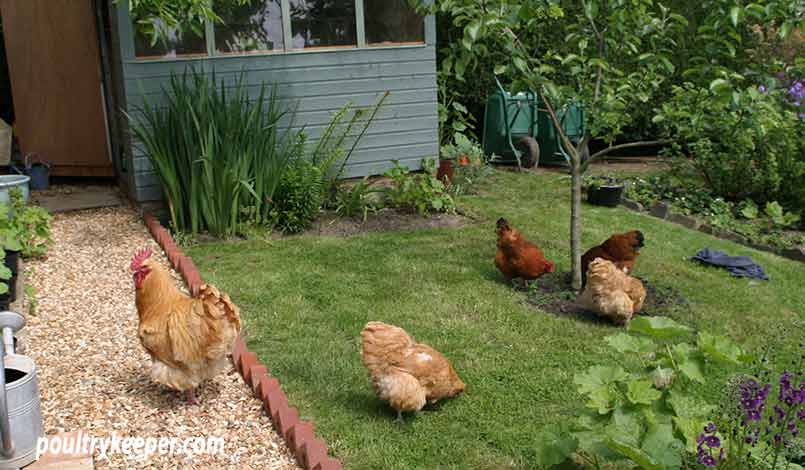
I always encourage people to let their hens out to free-range, even if it’s just for a couple of hours before dark into the garden. They will go back into their house to roost at night, so you don’t even have to catch them.
Feeding chickens during cold weather
The ratio of protein and energy chickens require in their diet varies according to the time of year.
During cold weather, chickens have higher energy requirements to keep warm, so they will need to eat more. Since the days are shorter, they also have less time to eat and, egg-laying will often have slowed or stopped.
Feeding chickens wheat and oats are useful energy boosts, and maize is very high in energy, so feed it judiciously. Good quality mixed corn (usually wheat plus cracked maize) is an excellent choice.
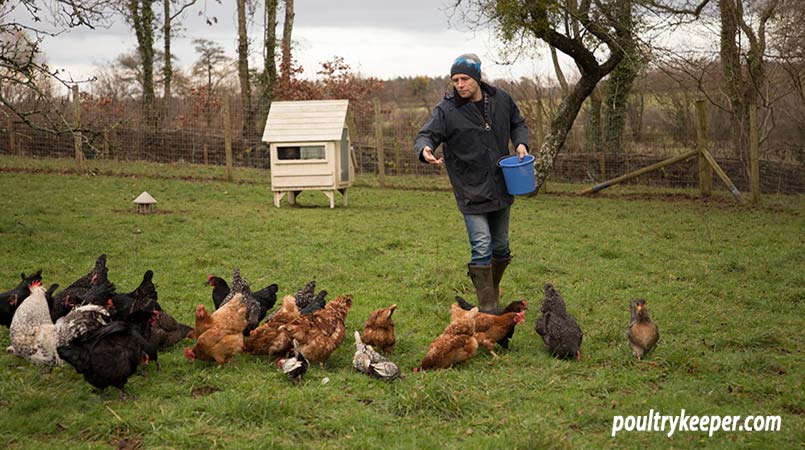
Feeding chickens during hot weather
During hot weather (30°C and above by my British standards!) it’s common for chickens to lay fewer eggs. The reason is simple. They require less energy, so eat less, but then they don’t have sufficient protein in their diet to continue laying eggs at the same rate.
It becomes even more critical during the summer to make sure your hens have their balanced feed before treats.
I stop feeding mixed corn during hot weather to make sure my birds are eating enough layers pellets.
In some hot regions of the world, layers rations with higher protein content are available for feeding chickens.
Calcium for laying hens
Are your hens getting enough?
Laying hens need more calcium in their diet to produce eggs since most of an egg’s shell consists of calcium carbonate. Layers ration contains about 3% calcium, and this is usually sufficient for most pullets. However, if you dilute a laying hens diet with other things (treats, mixed corn/scratch, even insects and greens such as grass they pick up while foraging), then they will need additional calcium to maintain strong eggshells.
Additional calcium is essential for hybrid layers and rehomed battery hens and other hens that produce a lot of eggs as well as for older hens whose eggshells will be getting thinner.
When hens don’t have sufficient calcium in their diet, they will start to draw it from their bones, and you may notice brittle and broken feathers.
How to supply additional calcium to your hens
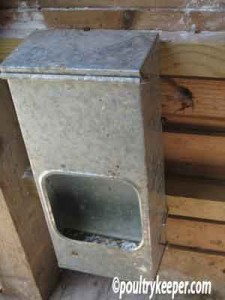 You can supply additional calcium for your hens in the form of soluble grit in a plastic grit hopper like this outside, or a wall-mounted hopper as shown in the photo here.
You can supply additional calcium for your hens in the form of soluble grit in a plastic grit hopper like this outside, or a wall-mounted hopper as shown in the photo here.
Soluble grit usually consists of limestone or crushed oyster shells and isn’t expensive to buy.
If you prefer, you can also dry out eggshells on a tray in your oven. Crush them into small pieces once they have dried out before feeding them to your hens in your hopper.
By using your oven to dry them, you will be killing any harmful bacteria. Never feed whole or broken eggs or even half-size eggshells that haven’t been dried and crushed to your hens because they may learn to break and eat eggs laid in their nests.
Egg eating is a tricky vice to cure once it starts!
Grit
Soluble or insoluble grit?
Don’t confuse soluble grit (calcium) with insoluble/flintstone grit (often, granite) which is necessary for hens eating anything except a formulated feed.
Related Articles:
You might also find this article useful:
- Poultry Grit - There are two types of grit. One is essential for digestion and the other for egg shell formation. Always make sure your hens can get enough.
Pasture-fed hens require insoluble grit; however, they often don’t eat much of it because they will pick up small amounts from the ground instead. Not all ground types have suitable stones, so I would suggest you always keep a small hopper of grit available.
A bag of ‘mixed grit‘ contains both soluble and insoluble grit and is the easiest way to provide both types of grit that your chickens will need.
JONDO MIXED
POULTRY GRIT
Probably one of the most popular brands of mixed poultry grit in the UK comes from JONDO.
John J. Doe & Son is a third-generation family business that has been making grit at their site, 6 miles west of Lincoln, since 1942.
A 25Kg bag may seem like a lot, but keep in mind that grit is heavy, so this is a good size for most small backyard flocks.
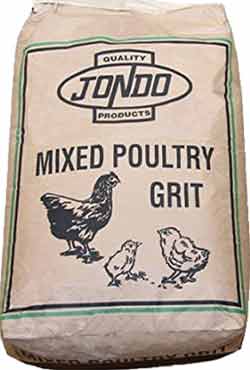
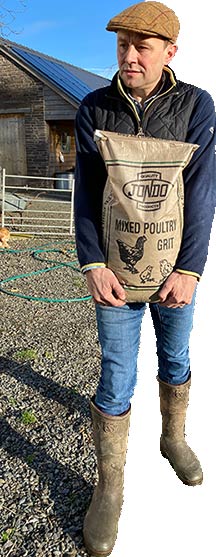
Drinking water
Fresh water is crucial for hens to be able to digest their food correctly and to produce eggs. Water should also be easily accessible by hens lower in the pecking order, so it is best to provide more than one place for them to drink.
Hens also need to drink lots of water to produce eggs, and even more during the summer months. Chickens cannot sweat, so during hot weather, they will pant and drink more to keep themselves cool.
If chickens run out of water, they will become stressed, dehydrate quickly and go off lay or into an early moult, so don’t forget to provide them with fresh water at all times.
I wrote about drinking water quality for chickens here.
ALWAYS provide fresh, clean drinking water for your chickens.
Finally
I hope you have a better understanding of how to feed chickens and your girls can benefit from this knowledge by staying fit and healthy and laying plenty of delicious eggs for you!
I would appreciate you liking or sharing my guide.

